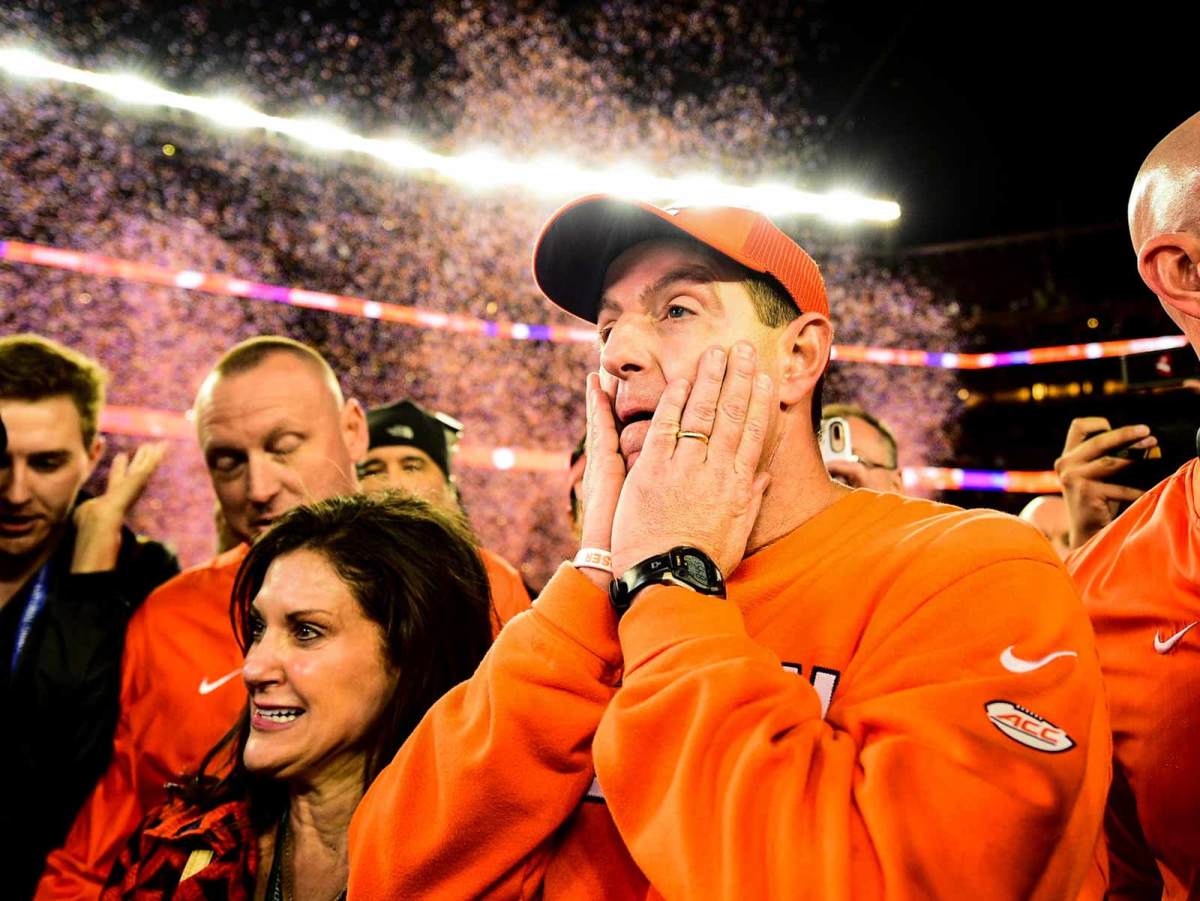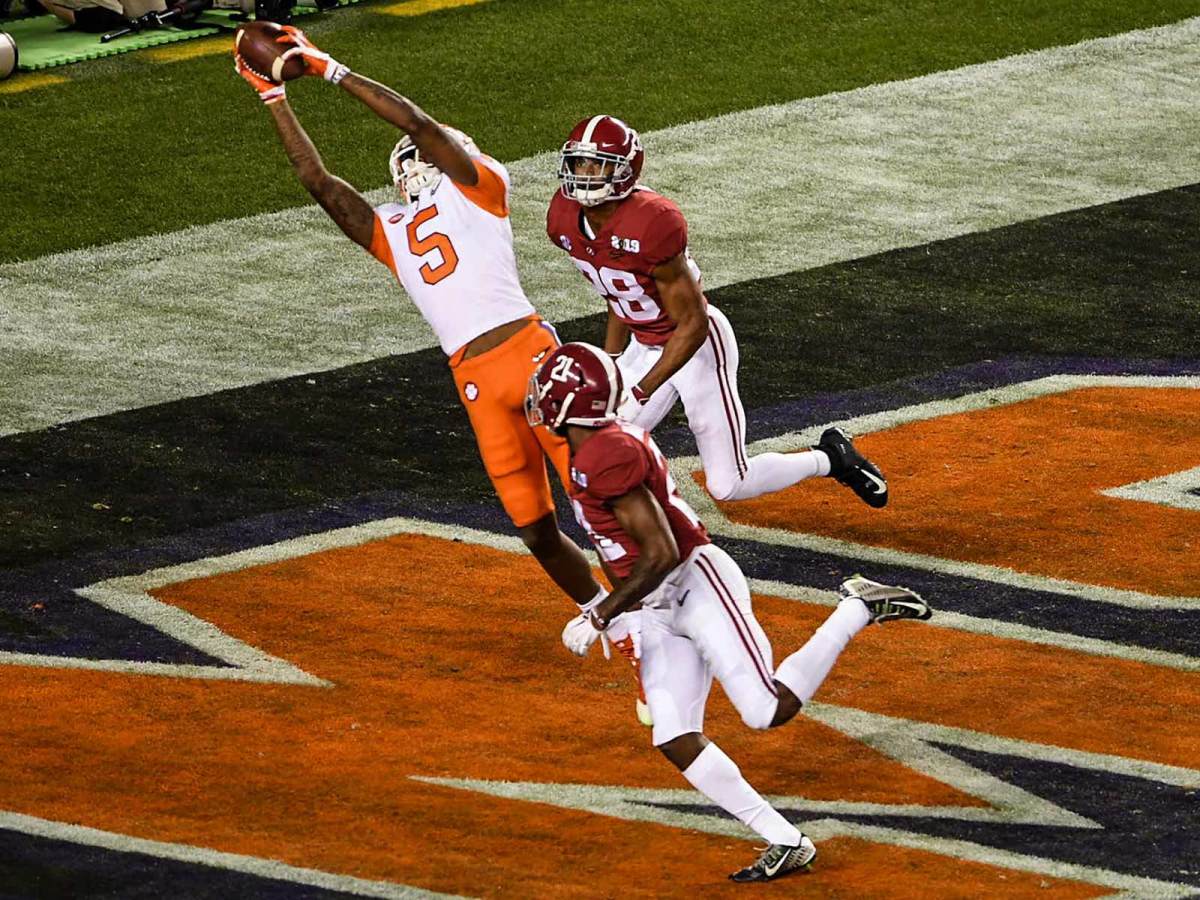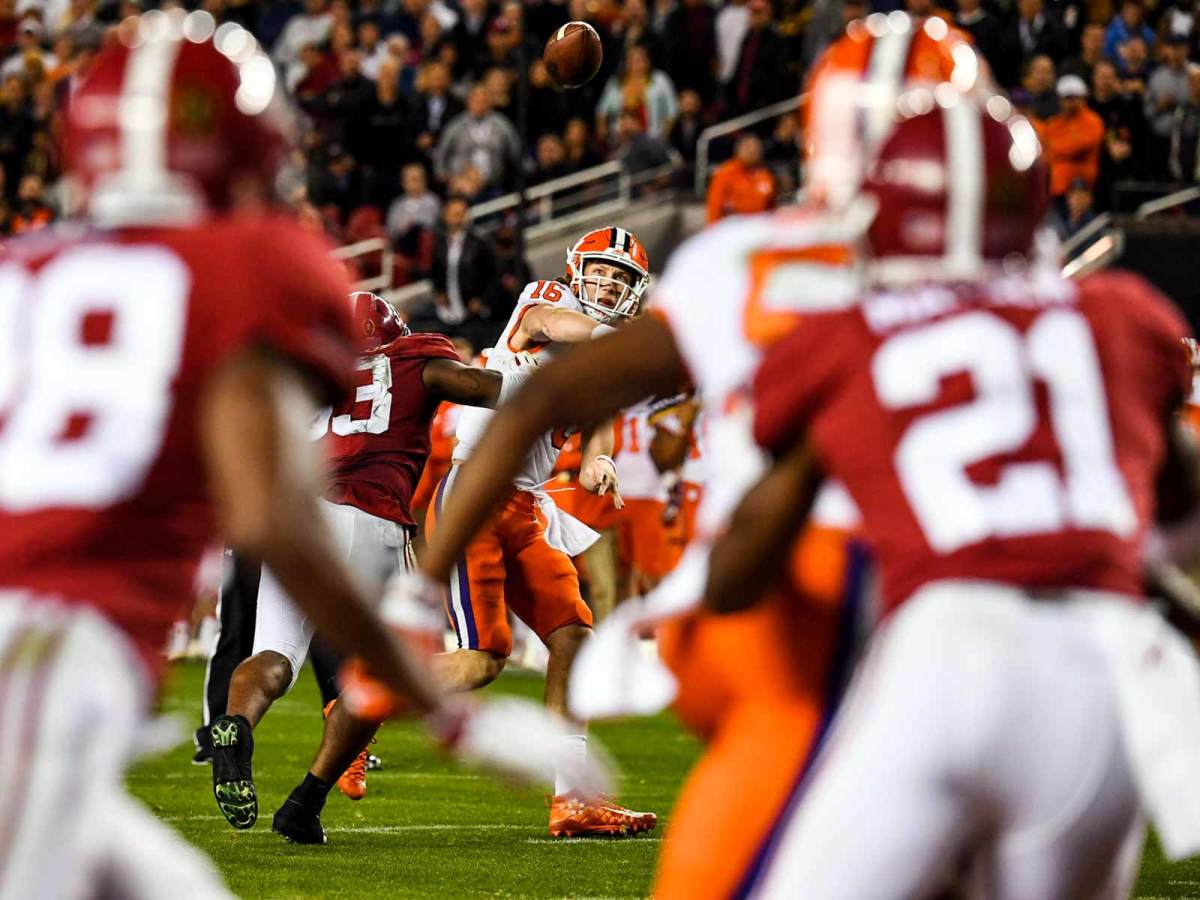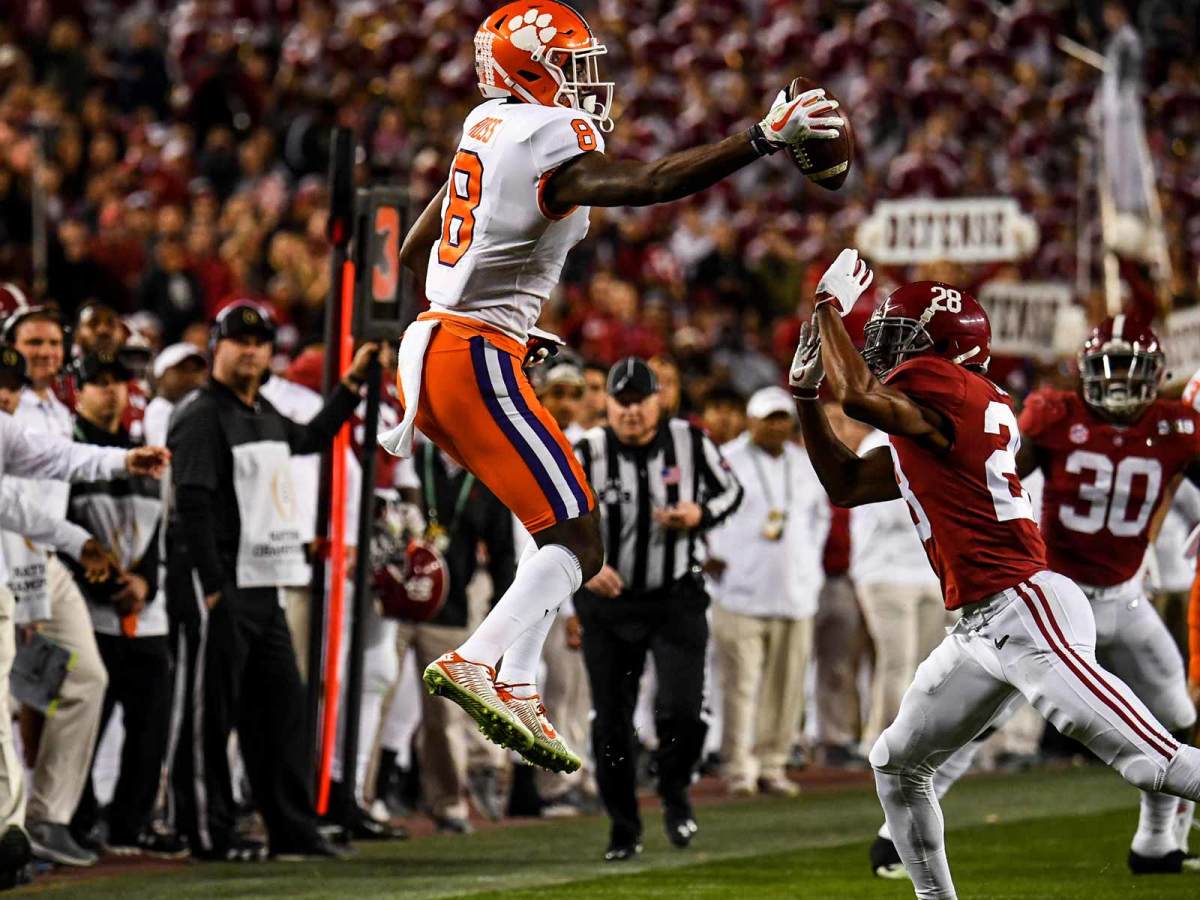Clemson Announces Its Arrival as the Program of College Football's Present and Future

What began with a prank call ended with a Wet Willie.
After losing to Alabama in last season’s College Football Playoff semifinal Clemson had a talented roster returning in 2018, but the Tigers’ national title dreams really began to crystallize last January, when defensive tackle Christian Wilkins called coach Dabo Swinney. A star who was sure to be coveted by several teams in the NFL draft, Wilkins gushed over his time at Clemson. Wilkins strung out his praise for Swinney, the staff and the school for what felt to Swinney like a solid minute. Swinney braced for goodbye. Instead, he got, “Coach, that’s why I’ve decided to come back.” Wilkins joined fellow defensive linemen Clelin Ferrell and Austin Bryant in putting off the NFL for a year. A team loaded with veterans who had seen everything and high-upside youngsters had a trio of legitimate stars returning to lead the way.
Nearly a year later, Wilkins stood behind Swinney on a stage at Levi’s Stadium in Santa Clara, Calif., with football-shaped confetti pouring down around them. As Swinney explained how Clemson’s second national title in three seasons might lead to more, Wilkins stuck his right index finger in his mouth, swished it around and then deposited that digit directly into Swinney’s right ear. That wouldn’t have happened had Alabama’s Nick Saban been standing on the stage again, but it seemed a perfect thank you for Swinney. He can coach his way to two national titles, but he’ll always remain down to earth enough to get a soggy earful from his most respected player.
A 44–16 annihilation of Alabama had made these Tigers the first undefeated national champion of the College Football Playoff era and the best team in school history. And even though Alabama had won five of the previous nine national titles, the events of Monday night raised an intriguing question. We know Clemson had the best team in the 2018 season. But given what the Tigers have done in the past three seasons and what they have returning, is Clemson currently the nation’s preeminent program?
The Tigers will lose Wilkins, Ferrell, Bryant and wideout Hunter Renfrow, who caught the winning TD when Clemson edged Alabama in the national title game two years ago. Yet they’ll bring back quarterback Trevor Lawrence, who on Monday became the first true freshman quarterback to start and win a national title game since Oklahoma’s Jamelle Holieway rang in 1986 by leading a 25–10 win against Penn State in the Orange Bowl. Lawrence, who turned 19 in October, threw for 347 yards and three scores against Bama. Also returning next season: freshman wideout Justyn Ross, who caught six passes for 153 yards and a touchdown, and sophomore cornerback A.J. Terrell, who started the avalanche with a 44-yard interception return for a touchdown in the first quarter that portended how Clemson would treat Alabama quarterback Tua Tagovailoa, the hero of last year’s national title game.
The Tigers’ win was a statement about the future of college football as much as the present. When the confetti shower was over, the night felt like the start of something even bigger than a single national championship party. It was a moment that had been 10 years in the making. And it all began with a very different kind of phone call.
Order SI's Clemson Championship Package | Shop 2019 Champs Gear

On a Monday morning 10 years earlier, Swinney, then a 38-year-old receivers coach, was summoned to the office of then-Clemson athletic director Terry Don Phillips. Moments earlier Phillips had informed Clemson’s staff that head coach Tommy Bowden was out with six games remaining on the 2008 schedule. The season had started with expectations of Clemson’s winning its first ACC title since 1991, but after a 3–3 start, the Tigers seemed destined for yet another season of mediocrity.
Even though the Tigers had two former head coaches on the staff, Bowden had suggested Phillips let Swinney lead the team the rest of the way. When told of his new role, Swinney didn’t view it as a head coaching job. He saw it as a seven-week babysitting gig. Before he met with Phillips, he called his wife, Kathleen. “We’ve been fired,” Swinney told his wife. “And it gets worse. I’m the interim.”
On the other end of the line, Kathleen started crying. The tears flowed because Bowden was a friend and because interim coaches rarely got the full-time job. The Swinneys had children in elementary school, and Kathleen dreaded uprooting them. Heck, the last time Dabo had been fired from a coaching job—at Alabama in 2000—he wound up selling commercial real estate for two years. But Kathleen knew if anyone had a chance, it was her husband. The boy she met as a first-grader in Pelham, Ala., had grown into a man who had prepared for this moment from the day he became a graduate assistant at Alabama 15 years earlier. He had binders detailing what he’d do if someone ever handed him the keys to a program.
Phillips had been watching the young assistant closely, and he agreed with Bowden that Swinney seemed up to the position, even though he’d never even been a coordinator. Phillips promised Swinney that at season’s end, he’d get an interview for the full-time job.
Swinney’s Tigers went 4–2 to finish the regular season, and the rest is history. How did Swinney turn a seven-week audition into a budding dynasty? How did Swinney create a juggernaut to rival Alabama? It’s easy to latch onto the coach’s fun, irreverent side as the key ingredient to his success: the aww shucks drawl; the corny jokes (he referenced Tone Loc’s “Funky Cold Medina” twice this season, once while explaining the simplicity of Clemson’s defensive play calls and once professing his love for obscure bowl sponsors); the pizza parties he throws for fans; his football facility that features a giant slide, a Wiffle ball field and a nap room. And because the talent upgrade he’s engineered at Clemson is so obvious, his recruiting ability also gets a share of the credit. But the one piece of Swinney’s managerial skill-set that often gets ignored is his ability to make uncomfortable and sometimes cutthroat decisions at precisely the right time. For a guy who seems so sentimental in every other part of his life, Swinney can be coldly calculating when he must be.
The first such decision came moments after he became the interim coach, when he fired offensive coordinator Rob Spence and decided that he and 29-year-old assistant Billy Napier would handle the play-calling. Another came a little more than two years later after Clemson’s offense had cratered and a 6–7 season in 2010 placed Swinney on the hot seat heading into ’11. Swinney fired Napier and hired Tulsa offensive coordinator Chad Morris, who was only one year removed from coaching high school ball in Texas. “When he did that, I said, ‘He’s got a chance,’ ” former boss Bowden says. “Because he can make the tough decisions.” When Swinney fired Napier, he also fired running backs coach Andre Powell. Swinney replaced Powell with former Clemson walk-on receiver Tony Elliott, who eventually would replace Morris as the Tigers’ play-caller when Morris got his first head coaching job at SMU following the 2014 season.
After Clemson closed a 10–4 season in 2011 by getting torched 70–33 by West Virginia in the Orange Bowl, Swinney fired defensive coordinator Kevin Steele. Steele eventually would become an excellent coordinator in the SEC, but at the time he struggled against the spread offenses taking over the game. Swinney hired Brent Venables away from Oklahoma. At Clemson, Venables became the first coordinator in the country to figure out how to run a dominant defense opposite an up-tempo, spread offense. That success attracted top-shelf players. In ’15, Clemson signed Wilkins, Ferrell and Bryant and a four-star defensive tackle named Albert Huggins (more on him later).
That fall Swinney and the Tigers broke Florida State’s three-year stranglehold on the ACC title and then reached the national championship game, losing a 45–40 thriller to Alabama. The next year the Tigers broke through, beating Alabama for the national title on Deshaun Watson’s last-second two-yard pass to receiver Renfrow. The departure of Watson to the NFL after that season left Clemson at another crossroads. Yes, the Tigers had built a program that could dominate the ACC year after year. They had stacked stars at receiver and on the defensive line. But could they find a quarterback who could win them another national title?

Perhaps that player was Watson’s backup, Kelly Bryant. Or maybe it would be Hunter Johnson, the class of 2017 signee from Brownsburg, Ind., whom recruiting site 247Sports had ranked the No. 2 quarterback prospect in the nation. Or darkhorse Chase Brice, a three-star 2017 recruit from nearby Loganville, Ga. Another potential QB savior arrived in 2018: a lanky, blond slinger from Cartersville, Ga., named Trevor Lawrence. To return to the national championship game, Swinney would have to make another difficult decision at quarterback—and get a critical cameo from the least likely candidate to emerge as a hero.
Bryant succeeded Watson and won 12 of his first 13 games as Clemson’s starter, but a 24–6 loss to No. 4 seed Alabama in last year’s national semifinal exposed his shortcomings against elite defenses. The Tigers couldn’t stretch the field through the air, and Bryant’s fleet feet were less helpful against defenders just as fast. Still, Bryant remained the favorite to start as a senior in 2018. Bryant, Johnson, Brice, and Lawrence all competed in spring practice, but Johnson transferred to Northwestern shortly afterward. Swinney promised the position battle would last through preseason camp but also proclaimed Bryant the leading candidate. Ultimately, the coaches decided Bryant would start but Lawrence would play the occasional series. That lasted until Lawrence relieved a less-than-effective Bryant in a 49–21 win at Georgia Tech on Sept. 22; the true freshman finished 13 of 18 with 176 passing yards and four touchdowns.
Though Swinney insists a new NCAA rule didn’t influence the timing of Clemson’s quarterback change, it’s difficult to believe it didn’t. Last June the NCAA passed a rule declaring that any player who hadn’t already redshirted could take a redshirt if he played in four or fewer games. Clemson had just played its fourth game. The Tigers were 16–2 in games Bryant started, but Swinney decided to give his true freshman the job heading into the Syracuse game on Sept. 29. Swinney allowed Bryant to miss Monday’s practice to process the news. When Bryant didn’t come to Tuesday’s practice, it was obvious he was considering using the redshirt rule to take a mulligan on his senior season at another school. Bryant, who already had a bachelor’s degree, could transfer and play immediately in 2019.
“It was just a weird situation,” Lawrence says. “He’s an older guy who has built relationships with these guys for four years and a great dude. That was more uncomfortable than anything on the field this year.”
Bryant’s teammates understood his decision—he ultimately chose to transfer to Missouri for 2019—but they had to move on. “We didn’t let it faze us as much as it might have other programs or other teams,” says Wilkins, whose decision along with his fellow defensive linemen gave Clemson a level of veteran leadership few teams could match. “It was, ‘Well, this is the decision that’s been made. We have to get behind it.’ We’re not going to let that stop us.”
As news broke that Bryant had left the team, Wilkins treated Lawrence to breakfast at Clemson’s SunnySide Cafe. “I was hungry,” Wilkins says with a grin. “I didn’t have a car. He was a ride.” Wilkins downplays the moment. Still, the fact that the team’s most respected player was dispensing wisdom to the new starting quarterback as controversy swirled seemed momentous. “I know when I was a freshman, I was dealing with a lot,” Wilkins says. “I handled it pretty well, but it wasn’t to the magnitude of what he has to go through being the quarterback. There’s so much more focus and spotlight and attention on him.”
Lawrence seems uniquely equipped to deal with that spotlight. Nothing seems to make his pulse rise. “I was talking to my girlfriend yesterday and she said, ‘You should sound excited sometimes when you’re talking to people,’ ” Lawrence said shortly before Clemson traveled to the Bay Area for the national title game. “But that’s just how I am.”

Lawrence may not get nervous on the field, but the anxiety crept in during a helpless moment late in the Tigers’ game against Syracuse days after Swinney’s quarterback swap. An injury to his head and neck had knocked out Lawrence in the second quarter. Now the season rode on Brice, who started spring practice fourth on the depth chart. Brice also could have transferred in the offseason to seek more playing time, but he had chosen to compete with Bryant and Lawrence. Those who stayed in Bo Schembechler’s Michigan program became champions. Thanks to a culture of competition at practice where everyone understands they must be ready when called upon, those who stay in Swinney’s program always seem prepared to step in and keep championship runs alive. With 2:50 remaining, the Tigers trailed by three and faced fourth-and-one. Then a false start penalty on right guard Gage Cervenka made it fourth-and-six from the Clemson 48-yard line. “Everything that could have gone wrong went wrong,” Clemson center Justin Falcinelli says. Tigers players didn’t know it then, but if they couldn’t convert that fourth down, they wouldn’t play for the ACC title and would have been shut out of the College Football Playoff.
Brice told Cervenka he had exactly one second to be mad at himself. Then he had to forget the mistake and block. Syracuse showed a six-man rush but sent only three—a classic trap designed to bait an inexperienced quarterback into panicking and throwing an interception. But the intense offseason quarterback competition had prepared Brice. When the Orange players dropped, he realized this look usually included a roving safety called a “robber” who would immediately break on the ball when he threw it. So Brice needed to throw the ball a tad quicker to give the robber less time to react. “As soon as I turned around,” says receiver Tee Higgins, “it was right there.” Higgins’s catch on the right sideline gained 20 yards, and it helped set up a two-yard Travis Etienne touchdown run to secure a 27–23 win. During their perfect regular season, the Tigers didn’t play another game decided by less than 20 points. “That was our season,” Renfrow says of the escape against Syracuse. “That’s really when we came together.”
At the Cotton Bowl the Tigers would need another backup who prepared like a starter to reach the national title game. Nine days before Clemson faced Notre Dame, officials learned that three players—including star defensive tackle Dexter Lawrence—had tested positive for a performance enhancer, Ostarine. The players maintained their innocence, but when their B samples also tested positive, the Tigers knew they’d have to play without Lawrence. While they hated that their teammate couldn’t play, they knew his backup would be a starter for almost any other program.
When SI photographed Wilkins, Dexter Lawrence, Bryant and Ferrell for the cover of the 2018 college football preview issue, Swinney nearly insisted that Huggins be in the photo because he considered him a co-starter. As the freshman quarterback who began the season as a backup torched the Fighting Irish defense (327 yards, three touchdown passes), Huggins helped Wilkins, Ferrell and Bryant stuff Notre Dame’s potent run game to 88 yards on the ground in a 30–3 smothering of the Irish.
Faced with the same choice as Bryant, Huggins could have left and started elsewhere. But defensive tackles can still play significant snaps even if they don’t start, and Swinney and Venables convinced Huggins his NFL dreams could still come true no matter what line on Clemson’s depth chart he occupied. So while Huggins understands Bryant’s decision, his own felt obvious to him. “When I committed here [in 2015], I committed here,” Huggins says. “I believe in coach Swinney and coach Venables. I stuck with it. There’s just something about it, man. I wouldn’t have been here if I didn’t trust them.”
In the championship game, Huggins made five tackles for a defense that shut out one of the nation’s most explosive offenses for the final 44:18. And in yet another reminder of the absurdity of Clemson’s defensive line depth, sophomore backup Nyles Pinckney snuffed out an Alabama fake field goal attempt early in the third quarter that might have given the Tide new life. Instead, Pinckney’s tackle set up two of Clemson’s youngest stars to slam the door on Alabama.

When they were recruiting Ross out of Phenix City, Ala., in the fall of 2017, Clemson coaches told the 6'4", 210-pound receiver that he could be the player who tilted the balance of power between the Tide and the Tigers. Alabama rarely misses on in-state players it wants, and the Tide wanted Ross. But neither Bama nor nearby Auburn could keep him from driving north on Interstate 85. In the class of 2018, the Tigers signed the top-ranked recruit from South Carolina (receiver Derion Kendrick), Alabama (Ross), Florida (defensive end Xavier Thomas), Georgia (Trevor Lawrence) and Ohio (offensive lineman Jackson Carman). It was a full-on flex from a program that had gone from perennial underachiever to national power in less than 10 years.
In the fourth straight playoff meeting between Alabama and Clemson, Ross and Lawrence certainly did tip the scales in the Tigers’ favor. On a third-and-eight play midway through the third quarter, Ross caught a ball on the right sideline and took it 74 yards for a touchdown to put Clemson up by 21. On Clemson’s next drive, Ross batted a ball to himself for a 37-yard catch on a third-and-12 play. He later made a one-handed grab along the right sideline for a 17-yard gain on third-and-nine. That helped set up a five-yard Lawrence-to-Higgins touchdown that confirmed the Tigers wouldn’t only beat Alabama. They would crush Alabama.
And now Swinney, the former Alabama walk-on receiver who got a seven-week audition 10 years ago, has done exactly what he envisioned. He has built Clemson into a program that expects to play for the national title every year. “To be successful, you have to have a vision for what you want to do and a clear plan,” Swinney said as he walked to the team bus after the championship victory. “And then you can’t be afraid to fail. You’ve got to keep getting up. That’s what we’ve done for 10 years.”
Then he walked on, planning already for the next 10.
